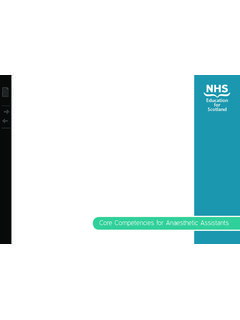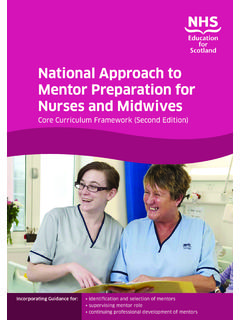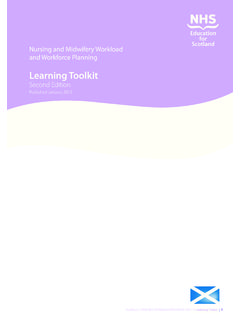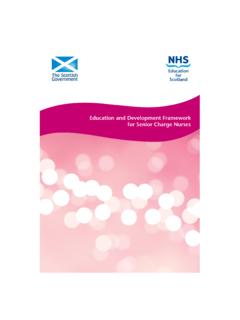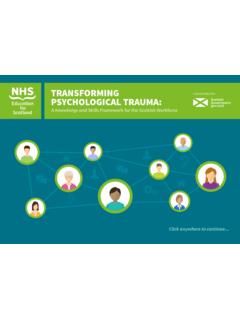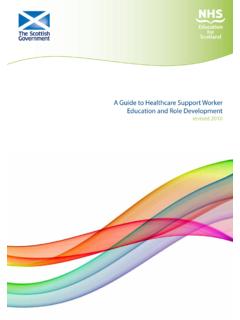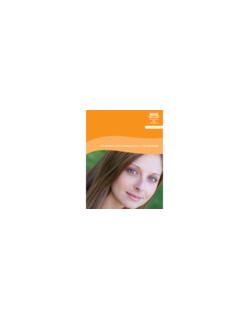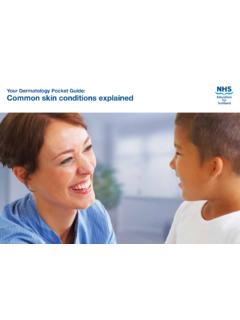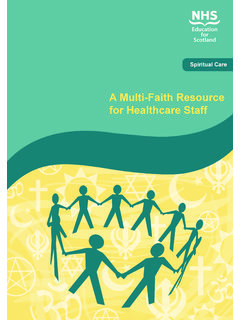Transcription of Portfolio of Core Competencies for Anaesthetic …
1 Nursing, Midwifery and Allied Health ProfessionsPortfolio of core Competencies for Anaesthetic AssistantsNursing, Midwifery and Allied Health ProfessionsPortfolio of core Competencies for Anaesthetic AssistantsNameAssessorCommencement DateJune 2012page 3 IndexIntroductionCommon Themes 1 4 Part A Sections 1 10 IntroductionThe Purpose of this DocumentAttitudes and ValuesDocument StructureTimeframeMaintaining CompetencyAssessment ProcessRoutes for CPD in Competent PracticeGuidelines for Continuous AssessmentWhat Constitutes EvidenceLearning ContractRecord of Clinical Assessor(s) andNominated Anaesthetist(s) Competencies 1 10 Competencies 11 20 Theme 1 Communication skills and professional relationshipsTheme 2 Professional developmentTheme 3 Clinical leadershipTheme 4 Clinical governanceGeneral core CompetenciesSection Preparation of patients for theatreSection Aspects of patient careSection Involvement in common Anaesthetic proceduresSection Involvement in airway managementSection Care of Anaesthetic machine.
2 Monitoring and related equipmentSection Care of equipment relevant to anaesthesiaSection Participation in intra-operative patient careSection Involvement with routine drugs / fluid therapySection Participation in post-operative patient careSection Involvement in emergency managementpage 4 IndexPart B Sections 11 20 AppendicesSpeciality-specific core CompetenciesSection Obstetric anaesthesia and analgesiaSection ENTS ection Cardiac anaesthesiaSection Thoracic anaesthesiaSection NeurosurgerySection PaediatricsSection Anaesthesia in Remote Locations (Interventional radiology (a) and ECT (b))Section Maxillo-facial surgerySection BurnsSection Inter-hospital adult patient transferAppendix 1 Qualification FrameworkAppendix 2 Glossary of Abbreviationspage 1 IntroductionIn the UK anaesthesia is administered under the supervision of a medically trained anaesthetist.
3 The profession has a good safety record, with morbidity and mortality figures which compare favourably with other first-world countries. The anaesthetist is either a fully qualified specialist or an experienced anaesthetist working under must provide a safe working environment for the practice of anaesthesia. Hospitals which have trainees may be subject to inspection by the Royal College of Anaesthetists to ensure that appropriate standards are maintained. Both the Royal College of Anaesthetists and the Association of Anaesthetists of Great Britain and Ireland would expect such standards to be maintained in all hospitals where anaesthesia is provided regardless of who administers it and recognise the Competencies within this document as appropriate for this group of Health provision of a suitably trained Anaesthetic Assistant (AA) is an essential safety standard, as published in the NHS Healthcare Improvement Scotland (NHS HIS) document Anaesthesia: Care Before, During and After Anaesthesia Standards and are members of the theatre team.
4 They are essential for the safe delivery of anaesthesia which requires two practitioners with complementary skills and knowledge. AAs are involved in many routine aspects of peri-operative care and play an important role in the safe management of unforeseen clinical adverse for AAs in Scotland is not unified. There are two streams: Operating Department Practitioners (ODPs), who complete a nationally recognised programme leading to the BSc in Operating Department Practice and are regulated by the Health Professions Council; AAs, who are Registered Nurses regulated by the Nursing and Midwifery Council. Training recognised by NHS HIS can either be a registered ODP qualification or completion of core Competencies 1 - 10 defined in this the publication of the core Competencies for Anaesthetic Assistants in 2006, a group was formed by NHS Education Scotland and the Advisory Board to the Royal College of Anaesthetists in Scotland to address the issues of endorsement of nursing courses and ensuring uniformity of standards across Scotland.
5 This group advised the setting up of the Scottish Multiprofessional Anaesthetic Assistants Development Group (SMAAD Group) which first met in 2007. Key to this process is the role of nominated Consultant Anaesthetists in every hospital in Scotland who perform a final sign-off and apply for certificates to be awarded by the SMAAD Group to all nurses who complete their Competencies . Registers are held of both Nominated Anaesthetists and nurses who have completed their Competencies by this in Scotland, working as AAs, should possess a certificate of competency, signed by a nominated Consultant Anaesthetist for each competency required in their work-place. Certificates are issued either after completion of a recognised course provided by a Health Education Institution or by completion of a Portfolio following an in-house programme under clinical structure addresses the issues relating to quality and consistency of education and training raised in the Scottish Medical and Scientific Advisory Committee (SMASAC) report Anaesthetic Assistance A Strategy for Training, Recruitment and Retention and the Promulgation of Safe Practice (2003).
6 Of core Competencies for Anaesthetic Assistants Introductionpage 2 The Purpose of this DocumentThe following pages define in detail the Competencies described in the NHS Education for Scotland (NES) document core Competencies for Anaesthetic Assistants (2011) and guide the assessment process. It is intended that the framework should form an overall level equivalent to level 9 of the Scottish Credit and Qualifications Framework (SCQF). See Appendix layout of this Portfolio is intended to make it easy to use by the Anaesthetic Assistant in the clinical area. The Anaesthetic Assistant can also add evidence of learning, reflective commentary etc into either a loose-leaf format or by links using the electronic pdf format. Throughout the Portfolio there are internet links to relevant documents to aid the Anaesthetic Assistant in achieving the stated the reflective and competency based elements of the Portfolio , Anaesthetic Assistants can accumulate evidence to demonstrate continuing competence, professional development and on-going education to meet KSF and to satisfy NMC/HPC requirements for registration Competencies meet the needs of the Association of Anaesthetists of Great Britain and Ireland referred to in the publication The Anaesthesia Team 3 (2010) and the current NHS HIS standards for Anaesthesia: Care Before, During and After Anaesthesia (2010) , Competencies do not include a number of mandatory training courses, such as moving and handling; basic life support; immediate life support; venepuncture and cannulation; intravenous therapy; safe blood transfusion and medical devices.
7 This document is intended to build on such aspects of induction and orientation, rather than replace Competencies also do not specify some elements of near-patient testing which may be delegated locally to the Anaesthetic assistant. Attitudes and ValuesThe framework is underpinned by the NHS QIS healthcare governance standards (2005), to ensure that: patients views and experiences are taken into account in the planning and delivery of services patients are involved in, and informed about, all decisions made during their journey of care systems are in place to ensure that patient safety is a core principle underpinning all aspects of healthcare delivery information is used appropriately to maximise benefit in all sectors of healthcare policies and procedures are in place to encourage and enable continuous quality improvement staff from across NHS Scotland are fully supported and adequately trained, both personally and professionally.
8 To provide high quality health services quality systems are in place to enable employees to play a full and active role in providing effective and efficient healthcare services for patients structures and processes are in place for the adequate review of service of core Competencies for Anaesthetic Assistants Introductionpage 3 Portfolio of core Competencies for Anaesthetic Assistants IntroductionDocument StructureThis document presents the Competencies in two parts. Part A presents 10 Competencies which form the essential core of AA education and training. All competent Anaesthetic Assistants will be expected to have achieved all ten of these Competencies or their equivalent such as an ODP qualification. These are broadly ordered as follows: background knowledge / core skills walk-through: pre-operative, intra-operative, post-operative emergency B comprises further groups of Competencies which are specific to certain Anaesthetic specialities.
9 To practise independently in one of these specialities an AA will need to have achieved and maintain where relevant the corresponding Competencies . Not all Anaesthetic Assistants will be expected to have completed every specific competency in this twenty sections of the Portfolio are broken down further into Competencies . The number of Competencies varies from section to section depending on the complexity of the competency. The skills and knowledge required to achieve each of the Competencies is provided beneath each competency. The final aspect of the framework layout is the indicators column. The indicators provide guidance as to what the trainee would be reasonably expected to know or demonstrate in the clinical setting. It also provides guidance to the clinical assessor(s) in what they should be looking for when assessing the trainee. The indicators provided are not exhaustive and are provided as examples. The trainee can demonstrate competency in other ways, provided that this fits into the overall framework and assessment process.
10 The indicators should not be viewed as a tick list, but used to ensure that across Scotland, individual trainees are being assessed in a similar way. Some sections also contain an overview relevant to that area of 4 TimeframeThese Competencies should be used in tandem with a personal development plan, linked to Flying Start and the NHS Knowledge and Skills normal circumstances it is expected that education and training follows the timeframe suggested by the SMASAC Report (2003) , with a further consolidation period undertaken during independent 1 2-3 Supervised daytime 3-9 Supervision as required during the day, supervised night 9 on Confirmation of Competencies , completion of training (including moving and handling, ILS and in-house practical skills training). Independent following core Competencies are subject to local guidelines and assessment and should be completed during supervised practice: immediate life support (ILS) ( ) insertion of an IV cannula ( ) IV drug administration / PCA ( et seq) the siting of an LMA in an adult patient ( ).
